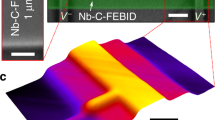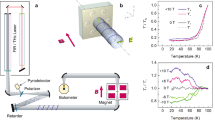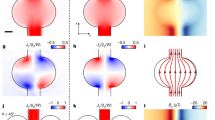Abstract
Many superconductors do not entirely expel magnetic flux—rather, magnetic flux can penetrate the superconducting state in the form of vortices. Moving vortices create resistance, so they must be ‘pinned’ to permit dissipationless current flow. This is a particularly important issue for the high-transition-temperature superconductors, in which the vortices move very easily1. Irradiation of superconducting samples by heavy ions produces columnar defects, which are considered2 to be the optimal pinning traps when the orientation of the column coincides with that of the vortex line. Although columnar defect pinning has been investigated using macroscopic techniques3,4, it has hitherto been impossible to resolve individual vortices intersecting with individual defects. Here we achieve the resolution required to image vortex lines and columnar defects in Bi2Sr2CaCu2O8+δ (Bi-2212) thin films, using a 1-MV field-emission electron microscope5. For our thin films, we find that the vortex lines at higher temperatures are trapped and oriented along tilted columnar defects, irrespective of the orientation of the applied magnetic field. At lower temperatures, however, vortex penetration always takes place perpendicular to the film plane, suggesting that intrinsic ‘background’ pinning in the material now dominates.
This is a preview of subscription content, access via your institution
Access options
Subscribe to this journal
Receive 51 print issues and online access
$199.00 per year
only $3.90 per issue
Buy this article
- Purchase on Springer Link
- Instant access to full article PDF
Prices may be subject to local taxes which are calculated during checkout



Similar content being viewed by others
References
Crabtree, G. W. & Nelson, D. R. Vortex physics in high-temperature superconductors. Phys. Today 50, 38–45 (1997).
Civale, L. et al. Vortex confinement by columnar defects in YBa2Cu3O7 crystals: Enhanced pinning at high fields and temperatures. Phys. Rev. Lett. 67, 648–651 (1991).
Hardy, V. et al. Accommodation of vortices to tilted line defects in very high-Tc superconductors with various electronic anisotropies. Phys. Rev. B 54, 656–664 (1996).
Schuster, Th. et al. Observation of in-plane anisotropy of vortex pinning by inclined columnar defects. Phys. Rev. B 50, 9499–9502 (1994).
Kawasaki, T. et al. Fine crystal lattice fringes observed using a transmission electron microscope with 1 MeV coherent electron waves. Appl. Phys. Lett. 76, 1342–1344 (2000).
Yao, Z., Yoon, S., Dai, H., Fan, S. & Lieber, C. M. Path of magnetic flux lines through high-Tc copper oxide superconductors. Nature 371, 777–779 (1994).
Harada, K. et al. Real-time observation of vortex lattices in a superconductor by electron microscopy. Nature 360, 51–53 (1992).
Tonomura, A. Electron Holography 2nd edn (Springer, Heidelberg, 1999).
Fanesi, S. et al. Influence of core misalignment and distortion on the Fresnel and holographic images of superconducting fluxons. Phys. Rev. B 59, 1426–1431 (1999).
Kotaka, Y. et al. Doping state and transport anisotropy in Bi2212 single crystals. Physica C 235–240, 1529–1530 (1994).
Klein, L., Yacoby, E. R., Yeshurun, Y., Konczykowski, M. & Kishio, K. Evidence for line vortices in Bi2Sr2CaCu2O8. Phys. Rev. B 48, 3523–3525 (1993).
Acknowledgements
We are grateful to N. Hatano for his discussions on tilted columnar defects, and to G. Pozzi, M. Beleggia, N. Osakabe, T. Yoshida and J. Masuko for their simulations of Lorentz micrographs of tilted vortex lines. We also thank F. Nori for discussions and T. Akashi and I. Matsui for help with the experiments.
Author information
Authors and Affiliations
Corresponding author
Rights and permissions
About this article
Cite this article
Tonomura, A., Kasai, H., Kamimura, O. et al. Observation of individual vortices trapped along columnar defects in high-temperature superconductors. Nature 412, 620–622 (2001). https://doi.org/10.1038/35088021
Received:
Accepted:
Issue Date:
DOI: https://doi.org/10.1038/35088021
This article is cited by
-
Tilted vortex cores and superconducting gap anisotropy in 2H-NbSe2
Communications Physics (2018)
-
Vortices and antivortices in two-dimensional ultracold Fermi gases
Scientific Reports (2017)
-
Imaging of surface spin textures on bulk crystals by scanning electron microscopy
Scientific Reports (2016)
-
Freezing and thawing of artificial ice by thermal switching of geometric frustration in magnetic flux lattices
Nature Nanotechnology (2014)
-
Ferromagnetic domain nucleation and growth in colossal magnetoresistive manganite
Nature Nanotechnology (2010)
Comments
By submitting a comment you agree to abide by our Terms and Community Guidelines. If you find something abusive or that does not comply with our terms or guidelines please flag it as inappropriate.



